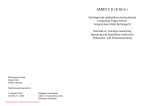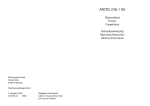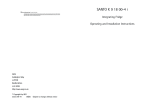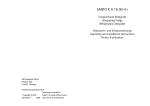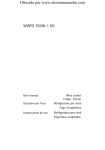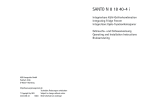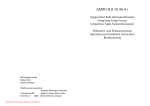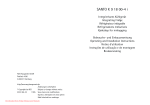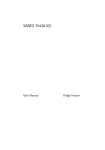Download Electrolux N 9 18 41-4 i Operating instructions
Transcript
SANTO N 9 18 41-4 i Integrating Fridge-Freezer Operating and Installation instruction Dear customer, Before placing your new refrigerator/freezer into operation please read these operating instructions carefully. They contain important information for safe use, for installation and for care of the appliance. Please keep these operating instructions for future reference. Pass them on to possible new owners of the appliance. These operating instructions are for use with several technically comparable models with varying accessories. Please observe the notes which apply to your model. Notes which are important for your safety or for the proper functioning of the appliance are stressed with a warning triangle and/or with signal words (Warning!, Caution!, Attention!). Please observe the following carefully. Supplementary information regarding operation and practical applications of the appliance appear after this symbol. Tips and notes concerning economical and environmentally sound use of the appliance are marked with the cloverleaf. The operating instructions contain instructions for the correction of possible malfunctions by the user in the section "What to do if ...". If these instructions should not be sufficient, our customer service department is always available to you. 2 Contents Safety . . . . . . . . . . . . . . . . . . . . . . . . . . . . . . . . . . . . . . . . . . . . . . . . . . . . . .4 Disposal . . . . . . . . . . . . . . . . . . . . . . . . . . . . . . . . . . . . . . . . . . . . . . . . . . . .6 Appliance Packaging Information . . . . . . . . . . . . . . . . . . . . . . . . . . . . . . .6 Disposal of old Appliances . . . . . . . . . . . . . . . . . . . . . . . . . . . . . . . . . . . .6 Remove transport safeguard . . . . . . . . . . . . . . . . . . . . . . . . . . . . . . . . . .6 Shelf holders . . . . . . . . . . . . . . . . . . . . . . . . . . . . . . . . . . . . . . . . . . . . . . . .7 Operating and indicator panel Fridge . . . . . . . . . . . . . . . . . . . . . . . . . .8 Starting up and temperature regulation . . . . . . . . . . . . . . . . . . . . . . . .9 Interior accessories . . . . . . . . . . . . . . . . . . . . . . . . . . . . . . . . . . . . . . . . .10 Fresh food refrigeration . . . . . . . . . . . . . . . . . . . . . . . . . . . . . . . . . . . . .11 Operating and indicator panel appliance . . . . . . . . . . . . . . . . . . . . . .12 Starting up and temperature regulation . . . . . . . . . . . . . . . . . . . . . . .13 Freezing and storing frozen food . . . . . . . . . . . . . . . . . . . . . . . . . . . . .15 Preparation of Ice Cubes . . . . . . . . . . . . . . . . . . . . . . . . . . . . . . . . . . . . .16 Freezing Calendar . . . . . . . . . . . . . . . . . . . . . . . . . . . . . . . . . . . . . . . . . . .16 Defrosting . . . . . . . . . . . . . . . . . . . . . . . . . . . . . . . . . . . . . . . . . . . . . . . . .16 Cleaning and Care . . . . . . . . . . . . . . . . . . . . . . . . . . . . . . . . . . . . . . . . . .17 Energy Saving Tips . . . . . . . . . . . . . . . . . . . . . . . . . . . . . . . . . . . . . . . . . .18 What to do if . . . . . . . . . . . . . . . . . . . . . . . . . . . . . . . . . . . . . . . . . . . . . .19 Correcting Malfunctions . . . . . . . . . . . . . . . . . . . . . . . . . . . . . . . . . . . . . .19 Changing the light bulb . . . . . . . . . . . . . . . . . . . . . . . . . . . . . . . . . . . . . .21 Regulations, Standards, Guidelines . . . . . . . . . . . . . . . . . . . . . . . . . . .21 Service and Spare Parts . . . . . . . . . . . . . . . . . . . . . . . . . . . . . . . . . . .22 Customer Care Department . . . . . . . . . . . . . . . . . . . . . . . . . . . . . . . . . .22 Guarantee Conditions . . . . . . . . . . . . . . . . . . . . . . . . . . . . . . . . . . . .23 Installation . . . . . . . . . . . . . . . . . . . . . . . . . . . . . . . . . . . . . . . . . . . . .24 Positioning . . . . . . . . . . . . . . . . . . . . . . . . . . . . . . . . . . . . . . . . . . . . .25 Your refrigerator needs air . . . . . . . . . . . . . . . . . . . . . . . . . . . . . . . . . . . .25 Housing dimensions . . . . . . . . . . . . . . . . . . . . . . . . . . . . . . . . . . . . . . . . .25 Reversing the door . . . . . . . . . . . . . . . . . . . . . . . . . . . . . . . . . . . . . . . . . .25 3 Safety The safety aspects of our refrigerators/freezers comply with accepted technical standards and the German Appliance Safety Law. Nevertheless, we consider it our obligation to make you aware of the following safety information: Intended use • The refrigerator is intended for use in the home. It is suitable for the cooling, freezing and storing of frozen food, as well as for making ice. If the appliance is used for purposes other than those intended or used incorrectly, no liability can be accepted by the manufacturer for any damage that may be caused. • Alterations or changes to the freezer are not permitted for reasons of safety. • If you use the refrigerator in a commercial application or for purposes other than the cooling, freezing or frozen storage of foods, please observe all valid legal regulations for your application. Prior to initial start–up • Check the refrigerator for transport damage. Under no circumstance should a damaged appliance be plugged in! In the event of damage, please contact the vendor. Refrigerant The refrigerant isobutane (R600a) is contained within the refrigerant circuit of the appliance, a natural gas with a high level of environmental compatibility, which is nevertheless flammable. • During transportation and installation of the appliance, be certain that none of the components of the refrigerant circuit become damaged. • If the refrigerant circuit should become damaged: – avoid open flames and sources of ignition; – thoroughly ventilate the room in which the appliance is situated. Safety of children • Packaging (e.g. wraps, polystyrene) can be dangerous for children. There is a risk of suffocation! Keep packaging material away from children! • Please make old appliances unusable prior to disposal. Pull out the mains plug, cut off the mains cable, break or remove spring or boltcatches, if fitted. By doing this you ensure that children cannot lock themselves in the 4 fridge when playing (there is risk of suffocation!) or get themselves into other dangerous situations. • Often children cannot recognise the hazards present in household appliances. It is therefore important that you ensure adequate supervision and never let children play with the appliance! Daily Operation • Containers with flammable gases or liquids can leak at low temperatures. There is a risk of an explosion! Do not store any containers with flammable materials such as, for example, spray cans, fire extinguisher refill cartridges etc in the refrigerator/freezer. • Bottles and cans must not be placed in the freezer compartment. They can burst when the contents freeze, high carbonate content drinks can even explode! Never store lemonade, juices, beer, wine, sparkling wine etc. in the freezer compartment. Exception: high alcohol content spirits can be stored in the freezer compartment. • Do not put ice creams or ice cubes in the mouth immediately after removal from the freezer compartment. Very cold ice can freeze to the lips or tongue and cause injury. • Do not touch frozen food with wet hands. Your hands could freeze to the food. • Do not operate any electrical appliances in the refrigerator/freezer (e.g. electric ice cream makers, mixers etc.). • Before cleaning the appliance, always switch off the appliance and unplug it, or pull the house fuse or switch off the circuit breaker. • When unplugging always pull the plug from the mains socket, do not pull on the cable. In case of malfunction • If the a malfunction occurs on the appliance, please look first in the "What to do if ..." section of these instructions. If the information given there does not help, please do not perform any further repairs yourself. • Refrigerators/freezers may only be repaired by qualified service engineers. Improper repairs can give rise to significant hazards. If your appliance needs repairing, please contact your specialist dealer or our Customer Service. • If the supply cord is damaged, it must be replaced by the manufacturer, its service agent or similarly qualified persons in order to avoid a hazard. 5 Disposal Appliance Packaging Information All materials are environmentally sound! They can be dumped or burned at an incinerating plant without danger! About the materials: The plastics can be recycled and are identified as follows: >PE< for polyethylene, e.g. the outer covering and the bags in the interior. >PS< for polystyrene foam, e.g. the pads, which are all free of chlorofluorocarbon. The carton parts are made from recycled paper and should be disposed of at a waste-paper recycling collection location. Disposal of old Appliances For environmental reasons, refrigeration appliances must be disposed of properly. This applies to your old appliance, and - at the end of its service life - for your new appliance as well. Warning! Before disposing of old appliances make them inoperable. Remove plug from mains, sever the power cable, remove or destroy any snap or latch closures. This eliminates the danger that playing children lock themselves into the appliance (danger of suffocation!) or place themselves into other life-endangering situations. Disposal: • The appliance may not be disposed of with domestic waste or bulky refuse. • The refrigerant circuit, especially the heat exchanger at the back of the appliance, may not be damaged. • The symbol on the product or on its packaging indicates that this product may not be treated as household waste. Instead it shall be handed over to the applicable collection point for the recycling of electrical and electronic equipment. By ensuring this product is disposed of correctly, you will help prevent potential negative consequences for the environment and human health, which could otherwise be caused by inappropriate waste handling of this product. For more detailed information about recycling of this product, please contact your local city office, your household waste disposal service or the shop where you purchased the product. Remove transport safeguard 6 The appliance and the interior fittings are protected for transport. • Pull off the adhesive tape on the left and right side of the door. • Remove all adhesive tape and packing pieces from the interior of the appliance. Shelf holders Your appliance is equipped with shelf retainers that make it possible to secure the shelves during transportation. To remove them proceed as follows: Raise the shelf from the back, push it in the direction of the arrow until it is free and remove the retainers. A B Installation Installation Location The appliance should be set up in a well ventilated, dry room. Energy use is affected by the ambient temperature. The appliance should therefore – not be exposed to direct sunlight; – not be installed next to radiators, or other sources of heat; – only be installed at a location whose ambient temperature corresponds to the climate classification, for which the appliance is designed. The climate classification can be found on the rating plate, which is located at the left on the inside of the appliance. The following table shows which ambient temperature is correct for each climate classification: each climate classification: Climate classification for an ambient temperature of SN +10 bis +32 °C N +16 bis +32 °C ST +18 bis +38 °C T +18 bis +43 °C If the refrigeration appliance is installed next to another refrigerator or freezer a clearance of 5 cm at the sides is required, in order to prevent the formation of condensation on the outside of the appliance. Important: if the supply cord is damaged, it must be replaced by manufacturer , its service agent or similarly qualified persons in order to avoid a hazard. 7 Operating and indicator panel Fridge °C °C °C A. B C D E F G B ALARM OFF ON/OFF ON/OFF A °C C D E F G Mains pilot indicator (green) Fridge button ON/OFF Temperature setting button (for warmer temperatures) Temperature display Temperature setting button (for colder temperatures) COOLMATIC function "on" indicator (yellow) COOLTMATIC button Temperature setting buttons • • The temperature is adjusted using the “C“ (+) and “E“ (-) buttons. These buttons are connected to the temperature display. The temperature display is switched over from the display of the ACTUAL temperature (Temperature display is illuminated) to the display of the DESIRED temperature (Temperature display flashes) by pressing one of the two buttons, “C“ (+) or “E“ (-). Each time one of the two buttons is pressed again the DESIRED temperature is adjusted by 1 °C. The DESIRED temperature must be reached within 24 hours. If neither button is pressed, the temperature display automatically switches back after a short period (approx. 5 sec.) to the display of the ACTUAL temperature. DESIRED temperature means: The temperature that has been selected for inside the fridge. The DESIRED temperature is indicated by flashing numbers. ACTUAL temperature means: The temperature display indicates the current temperature inside the fridge. The ACTUAL temperature is indicated with illuminated numbers. Temperature display The temperature display can indicate several pieces of information. 8 • • During normal operation, the temperature currently present in the fridge (ACTUAL temperature) is displayed. When the temperature is being adjusted a flashing display indicates the fridge temperature currently set (DESIRED temperature). Starting Up - Setting the Temperature 1. 2. 3. 4. 5. Plug the mains plug into the mains socket. Press ON/OFF, button B can function the fridge compartment separately with the appliance in function. The green mains pilot indicator illuminates. Press either the “C“ (+) or “E“ (-) button. The temperature display switches over and the DESIRED temperature currently set flashes on the temperature display. Set the required temperature by pressing the “C“ (+) or “E“ (-) buttons (see section "Temperature setting buttons"). The temperature display will immediately show the changed setting. Each time the button is pressed the temperature is adjusted by 1 °C. From a food safety point of view +5 °C should be considered sufficiently cold for storing food in the fridge. Once the required temperature has been set, after a short period (approx. 5 sec.) the temperature display will change and again indicate the current ACTUAL temperature inside the fridge. The display will change from flashing to continuous illumination. Information! When the setting is changed, the compressor does not start immediately if automatic defrosting is currently taking place. As the storage temperature within the fridge is reached quickly you can store food immediately after switching on. Important: If the fridge compartment is off, the door must be closed in order that the freezer is working properly. In this condition, the electronic control of the appliance functions automatically and periodically circulating the air to prevent unpleasant smells and humidity. COOLMATIC 1. 2. The COOLMATIC function is suited for quick cooling of large quantities of goods in the refrigerator. The COOLMATIC function is switched on by pressing the COOLMATIC button. The yellow light illuminates. The COOLMATIC function now provides for intensive cooling. A DESIRED temperature of +2 °C is automatically selected. The COOLMATIC function is ended automatically after a period of 6 hours. The COOLMATIC function can be ended manually at any time by pressing the COOLMATIC button again. The yellow light goes out. 9 Interior Accessories Storage Shelves The glass shelf above the fruit and vegetable compartment should always remain in position, to ensure fruit and vegetables stay fresh longer. The remaining storage shelves can be adjusted to various heights: Pull the storage shelf forward until it can be tipped up or down and remoD338 ved. To insert at a different height use the same procedure in reverse. Adjustment for tall goods: Remove the front half of the two-part vario glass storage shelf and insert it at a different level. Space is thus gained for storage of tall goods on the underlying storage shelf. Variable Inner Door The door compartments can be pulled up and removed, and inserted at other positions as needed. Moisture regulator There is an adjustable air grille in front of the shelf above the fruit and vegetable compartments. The opening in the ventilation slots can be adjusted with the slider. Right slider: Ventilation slots opened. With the ventilation slots open, more air circulation results in a lower air moisture content in the fruit and vegetable compartments. 10 Left slider: Ventilation slots closed. When the ventilation slots are closed, the natural moisture content of the food in the fruit and vegetable compartments is preserved for longer. Variable Storage Box 1. 2. Some models are equipped with a variable storage box which is fitted under a door shelf compartment and can be slid sideways. The box can be inserted under any door shelf compartment. To change the position of the storage box; lift the shelf compartment with the box upwards and out of the holders in the door and remove the retaining bracket out of the guide under the shelf compartment. Reverse the above operation to insert the shelf at a different height. Fresh food refrigeration To obtain the best performance: • do not store warm food or evaporating liquid in the refrigerator • do cover or wrap the food, particularly if it has a strong flavour. • Position food so that air can circulate freely round it. Useful hints: Meat (all types): wrap in polythene bags and place on the glass shelf above the vegetable drawer(s). For safety, store in this way only one or two days at the most. Cooked foods, cold dishes, etc: these should be covered and may be placed on any shelf. Fruit and vegetables: these should be thoroughly cleaned and placed in the special drawer(s) provided. Butter and cheese: these should be placed in special airtight containers or wapped in aluminium foil or polythene bags to exclude as much air as possible. 11 Milk bootles: these should have a cap and should be stored in the bottle rack on the door. Bananas, potatoes, onions and garlic, if not packed, must not be kept in the refrigerator. Operating and indicator panel appliance °C ON/OFF °C ALARM OFF ON/OFF H H. I. J. K. L. M. N. O. P. °C °C I J K L M N O P Mains pilot indicator (green) Button ON/OFF for the appliance Temperature setting button (for warmer temperatures) Temperature display Temperature setting button (for colder temperatures) FROSTMATIC function "on" indicator (yellow) FROSTMATIC button Alarm reset light Alarm reset button Temperature setting buttons • • 12 The temperature is adjusted using the “J“ and “L“ buttons. These buttons are connected to the temperature display. The temperature display is switched over from the display of the ACTUAL temperature (Temperature display is illuminated) to the display of the DESIRED temperature (Temperature display flashes) by pressing one of the two buttons, “J” or “L“. Each time one of the two buttons is pressed again the DESIRED temperature is adjusted by 1 °C. The DESIRED temperature must be reached within 24 hours. If neither button is pressed, the temperature display automatically switches back after a short period (approx. 5 sec.) to the display of the ACTUAL temperature. DESIRED temperature means: The temperature that has been selected for inside the freezer. The DESIRED temperature is indicated by flashing numbers. ACTUAL temperature means: The temperature display indicates the current temperature inside the freezer. The ACTUAL temperature is indicated with illuminated numbers. Temperature display The temperature display can indicate several pieces of information. • During normal operation, the temperature currently present in the freezer (ACTUAL temperature) is displayed. • When the temperature is being adjusted a flashing display indicates the freezer temperature currently set (DESIRED temperature). Starting Up - Setting the Temperature 1. 2. 3. 4. 5. 6. Plug the mains plug into the mains socket. Press ON/OFF button (I) for the functioning of the whole appliance. The green mains pilot indicator illuminates. The alarm light flashes since the temperature is reached. The buzzer sounds. Pressing button “P” the buzzer stops. Press either the “J“ or “L” button. The temperature display switches over and the DESIRED temperature currently set flashes on the temperature display. Set the required temperature by pressing the “J“ or “L“ buttons (see section "Temperature setting buttons"). The temperature display will immediately show the changed setting. Each time the button is pressed the temperature is adjusted by 1 °C. From a food safety point of view -18 °C should be considered sufficiently cold for storing food in the freezer. The alarm light,when the set temperature is reached. Press the alarm button to turn off the buzzer. Ice pack There are 2 ice packs in one drawer of the freezer. In the event of a power failure or malfunction, the ice pack will lengthen the amount of time it takes for the frozen food to become too warm by several hours. The ice pack can only fulfil this task optimally if it is placed in the uppermost drawer, at the front, above the frozen food. You can use the ice pack for cooling cold bags. 13 FROSTMATIC 1. 2. The FROSTMATIC function accelerates the freezing of fresh food and, at the same time, protects foodstuffs already stored from undesirable warming. The FROSTMATIC function is switched on by pressing the FROSTMATIC button. The yellow light illuminates. If the FROSTMATIC function is not ended manually, the appliance switch off the FROSTMATIC function after 52 hours. The yellow light goes out. The FROSTMATIC function can be ended manually at any time by pressing the FROSTMATIC button again. The yellow light goes out. Alarm reset button In the event of an abnormal temperature rise inside the freezer (e.g. power cut) warning light (O) will start to flash and a buzzer will sound. After the temperature has returned to normal, the warning light (O) will continue to flash, although the buzzer has stopped. When the alarm button is pressed, the warmest temperature reached in the compartment flashes on the indicator. Switching the Appliance off 1. 2. 3. 14 The refrigerator compartment can be switched off independently of the freezer compartment. By the switching off of the freezer compartment it is switched off also the refrigerator compartment. To switch off the refrigerator, hold down the ON/OFF button (B) for the refrigerator for a count of 5 Sec. . To switch off the appliance hold down the ON/OFF button (I) for approx. 5 seconds. This will result in a count down from "3" to "1" taking place in the temperature display. On reaching "1" the appliance will switch off. The temperature display will go off. Note: The appliance cannot be switched on or off if unplugged, or if there is no power being supplied to it. Following connection to the mains power supply, the appliance returns to the same operating state as before the interruption of main power. If the appliance is not going to be used for an extended period: Switch off the appliance, holding down the ON/OFF button (I) until the display goes off (see above). Remove the mains plug or switch off or turn out the circuit breaker or fuse. Finally, leave the doors open so as to avoid a build up of odours. Freezing and storing frozen food You can use your freezer for freezing fresh food yourself. Important! 1. 2. • The temperature in the freezer compartment must be –18 °C or colder before freezing food. • Please observe the freezing capacity given on the rating plate. The freezing capacity is the maximum quantity of fresh food that can be frozen within a period of 24 hours. If you wish to freeze food several days in a row, please observe a maximum capacity of only 2/3 to 3/4 of that on the rating plate. The quality of the food is best preserved when it is frozen right through to the core as quickly as possible. • Allow warm food to cool down before freezing. The warmth will cause increased ice formation and increase the power consumption. • Please note the maximum storage times specified by the manufacturer. • Thawed foods which have not been processed further (cooked into meals) may not under any circumstances be frozen a second time. • Containers with flammable gases or liquids can leak at low temperatures. There is a risk of an explosion! Do not store any containers with flammable materials such as, for example, spray cans, fire extinguisher refill cartridges etc in the refrigerator/freezer. • Bottles and cans must not be placed in the freezer. They can burst when the contents freeze, high carbonate content drinks can even explode! Never store lemonade, juices, beer, wine, sparkling wine etc. in the freezer. Exception: high alcohol content spirits can be stored in the freezer. • All foods must be packed air tight prior to freezing, so that they do not dry out or lose their flavour, and so that no flavour contamination of other frozen goods occurs. Caution! Do not touch frozen food with wet hands. Your hands could freeze to the food. Place the packed food in the drawers. Place food to be frozen in the compartment as per the diagram.. Unfrozen food must not touch items already frozen, otherwise the frozen X food could begin to defrost. Place frozen foods in the drawers sorted by type, as far as possible. 15 Preparation of Ice Cubes 1. 2. Fill the ice cube tray 3/4 full with cold water, place it in the freezer compartment and leave to freeze. To loosen the frozen cubes, either bend the ice cube tray or hold it under running water for a few seconds. Important! Never try to free an ice tray that is frozen to the freezer compartment using pointed or sharp edged objects. Use the ice scraper supplied. Freezing Calendar • The symbols on the drawers show different types of frozen goods. • The numbers indicate storage times in months for the appropriate types of frozen goods. Whether the upper or lower value of the indicated storage time is valid depends on the quality of the foods and pre-treating before freezing. The lower value applies to foods with high fat content. Defrosting Refrigerator Frost is automatically eliminated from the evaporator of the refrigerator compartment every time the motor compressor stops, during normal use. The defrost water drains out through a trough into a special container at the back of the appliance, over the motor compressor, where it evaporates. Freezer The freezer compartment of this model, on the other hand, is a "no frost" type. This means that there is no buildup of frost when it is in operation, neither on the internal walls nor on the foods. The absence of frost is due to the continuous circulation of cold air inside the compartment, driven by an automatically controlled fan. 16 Cleaning and Care For hygienic reasons the appliance interior, including interior accessories, should be cleaned regularly. Warning! 1. 2. 3. 4. • The appliance may not be connected to the mains during cleaning. Danger of electrical shock! Before cleaning switch the appliance off and rem ve the plug from the mains, or switch off or turn out the circuit breaker or fuse. • Never clean the appliance with a steam cleaner. Moisture could accumulate in electrical components, danger of electrical shock! Hot vapours can lead to the damage of plastic parts. • The appliance must be dry before it is placed back into service. Attention! • Ethereal oils and organic solvents can attack plastic parts, e.g. – lemon juice or the juice from orange peals; – butyric acid; – cleansers which contain acetic acid. Do not allow such substances to come into contact with appliance parts. • Do not use any abrasive cleansers. Remove frozen food and the food from the refrigerator. Wrap frozen food in several layers of newspaper. Store it in a cool place, well covered. Switch the appliance off and remove the plug from the mains, or switch off or turn out the circuit breaker or fuse. Clean the appliance and the interior accessories with a cloth and lukewarm water. Commercially available dish washing detergents may also be used. Important: Insert the 2 upper shelves in the original position after leaving them for cleaning. After cleaning wipe with fresh water and rub dry. Accumulation of dust at the condenser increases energy consumption. For this reason carefully clean the condenser at the back of the appliance once a year with a soft brush or a vacuum cleaner. 17 Energy Saving Tips • Do not install the appliance near radiators or other sources of warmth. High ambient temperatures cause longer, more frequent operation of the compressor. • Ensure sufficient air circulation and exhaust at the appliance base and at the back wall of the appliance. Never cover air vent openings. • Do not place warm foods into the appliance. Allow warm foods to cool first. • Only leave door open as long as necessary. • Do not set temperature any colder than necessary. • Put frozen food in the fridge to defrost. The cold in the frozen food will then be used to cool the fridge. • Keep the heat emitting condenser, the metall grille on the rear wall of your appliance, always clean. 18 What to do if ... Correcting Malfunctions A malfunction may be caused by only a minor fault that you can rectify yourself using the following instructions. Do not perform any other work on the appliance if the following information does not provide assistance in your specific case. Warning! Repairs to refrigerators/freezers may only be performed by qualified service engineers. Improper repairs can give rise to significant hazards for the user. If your appliance needs repairing, please contact your specialist dealer or our Customer Service. Malfunction Possible Cause Remedy Appliance is not switched on Switch on the appliance. Mains plug is not plugged in Insert mains plug. or is loose. Appliance does not work, no pilot light is illuminated. Fuse has blown or is defective. Check fuse, replace if necessary. Socket is defective. Mains malfunctions are to be corrected by an electrician. Green light does not light up, yellow light lights up when Green light faulty. fast freeze fuction is activated, appliance is on. Please inform your customer service Yellow light does not light up, when fast freeze fuction is Yellow light faulty. activated, appliance is on. Please inform your customer service Appliance cools too much. Turn the temperature regulator to a warmer setting temporarily.. Temperature is set too cold. 19 Malfunction Possible Cause Temperature is not properly adjusted. Remedy Please look in the "Initial Start Up" section. Open the door only as long as Door was open for an extennecessary.. Press the fast freeded period. ze switch A large quantity of warm The freezer temperature is not food was placed in the sufficient, red light lights up, appliance within the last 24 temperature signal sounds hours. Press the fast freeze switch The appliance is near a heat source. Please look in the "Installation location" section. Problems on the appliance Switch on the fast freeze switch, keep the freezer closed, inform your customer service Carefully warm the leaking sections of the door seal with Door seal is not air tight (pos- a hair dryer (not hotter than Heavy build up of frost, possisibly after changing over the approx. 50 °C). At the same bly also on the door seal. time shape the warmed door hinges). seal by hand such that it sits correctly. Appliance is not level. Readjust the feet. The appliance is touching the Move the appliance slightly. wall or other objects. Unusual noises. A component, e.g. a pipe, on If necessary, carefully bend the rear of the appliance is the component out of the touching another part of the way. appliance or the wall. 20 The compressor does not start This is normal, no error has immediately after changing occurred. the temperature setting. The compressor starts after a period of time. If the door remains open for more than 7 min., the light will be switched off by the electronics. Close the door and re-open it, the light will function automatically again. This is normal, no error has occurred. Changing the light bulb 1. 2. 3. 4. 5. 6. Warning! There is a risk of electric shocks! Before changing the light bulb, switch off the appliance and unplug it, or pull the fuse or the circuit breaker. Light bulb data: Replace the lamp with one of the same power (the maximum power is shown on the light diffuser). To switch off the appliance, press the ON/OFF buttons (I). Unplug the mains plug. To change the light bulb press on the rear hook and at the same time slide the cover in the direction indicated by the arrow. Change the defective light bulb. Refit the light bulb cover. Put the refrigerator back into operation. Regulations, Standards, Guidelines This appliance was designed for household use and was manufactured in accordance with the appropriate standards. The necessary measures in accordance with appliance safety legislation regulations (GSG), accident prevention regulations for refrigeration appliances (VBG 20) and the regulations of the German Society of Electrical Engineers (VDE) were observed in the manufacture of this appliance. The refrigerant circuit has been checked for leaks. This appliance is in accordance with the following EU guidelines: – 73/23/EWG dated 19 February 1973 - low voltage guidelines. – 89/336/EWG dated 3 May 1989 (including guideline change notice 92/31/EWG) - EMV guideline 21 Service and Spare Parts In the event of your appliance requiring service, or if you wish to purchase spare parts, please contact your local Service Force Centre by telephoning: 0870 5 929929 Your telephone call will be automatically routed to the Service Force Centre covering your post code area. For address of your local Service Force Centre and further information about Service Force, please visit the website at www.serviceforce.co.uk. Before calling out an engineer, please ensure you have read details under the heading “Something Not Working”. When you contact the Service Force Centre you will need to give following details: 1. Your name, address and post code 2. Your telephone number 3. Clear and concise details of the fault 4. The model and serial number of the apliance. (found on the rating plate). 5. The purchase date Please note that a valid purchase receipt or guarantee documentation is required for in-guarantee service calls. Customer Care Department For general enquiries concerning your AEG appliance or for futher information on AEG products, please contact our Customer Care Department by letter or telephone at the address below or visit our website at www.aeg.co.uk. Customer Care Department Major Appliances AEG Domestic Appliances Addington Way Luton Bedfordshire LU4 9 QQ Tel: 08705 350 350* * calls to this number may be recorded for training purposes For Customer Services in the Republic of Ireland please contact us at the address below: AEG Electrolux Group (Irl) Ltd Long Mile Road Dublin 12 - Republic of Ireland Tel: +353 (0) 1 4090751 Email: [email protected] 22 GUARANTEE CONDITIONS Standard guarantee conditions We, AEG, undertake that if within 12 months of the date of the purchase this AEG appliance or any part thereof is proved to be defective by reason only of faulty workmanship or materials, we will, at our discretion repair or replace the same FREE OF CHARGE for labour, materials or carriage on condition that: · The appliance has been correctly installed and used only on the electricity or gas supply stated on the rating plate. · The appliance has been used for normal domestic purposes only, and in accordance with the manufacturer's operating and maintenance instructions. · The appliance has not been serviced, maintained, repaired, taken apart or tampered with by any person not authorised by us. · All service work under this guarantee must be undertaken by a Service Force Centre. Any appliance or defective part replaced shall become the Company's property. · This guarantee is in addition to your statutory and other legal rights. · Home visits are made between 8.30am and 5.30pm Monday to Friday. Visits may be available outside these hours in which case a premium will be charged. Exclusions This guarantee does not cover: · Damage or calls resulting from transportation, improper use or neglect, the replacement of any light bulbs or removable parts of glass or plastic. · Costs incurred for calls to put right an appliance which is improperly installed or calls to appliances outside the United Kingdom. · Appliances found to be in use within a commercial environment, plus those which are subject to rental agreements. · Products of AEG manufacture which are not marketed by AEG. European Guarantee If you should move to another country within Europe then your guarantee moves with you to your new home subject to the following qualifications: · The guarantee starts from the date you first purchased your product. · The guarantee is for the same period and to the same extent for labour and parts as exists in the new country of use for this brand or range of products. · This guarantee relates to you and cannot be transferred to another user. · Your new home is within the European Community (EC) or European Free Trade Area. · The product is installed and used in accordance with our instructions and is only used domestically, i.e. a normal household. · The product is installed taking into account regulations in your new country. Before you move please contact your nearest Customer Care centre, listed below, to give them details of your new home. They will then ensure that the local Service Organisation is aware of your move and able to look after you and your appliances. France Senlis +33 (0)3 44 62 29 29 Germany Nürnberg +49 (0)800 234 7378 Italy Pordenone +39 (0)800 117511 Sweden Stockholm +46 (0)8 672 53 60 UK Luton +44 (0) 8705 350 350 23 Installation Electrical Connection Any electrical work required to install this appliance should be carried out by a qualified electrician or competent person. WARNING – THIS APPLIANCE MUST BE EARTHED The manufacturer declines any liability should these safety measures not be observed. Before switching on, make sure the electricity supply voltage is the same as that indicated on the appliance rating plate. The rating plate is inside, on the left. The appliance is supplied with a 13 amp plug fitted. In the event of having to change the fuse in the plug supplied, a 13 amp ASTA approved (BS 1362) fuse must be used. Important! 13 AMP The wires in the mains lead are GREEN & YELLOW 13 AMP. FUSE coloured in accordance with the following code: Green and Yellow Earth Blue Neutral Brown Live As the colours of the wires in the mains lead of this appliance may not BROWN correspond with the coloured markBLUE ings identifying the terminals in your CORD CLAMP D207 plug, proceed as follows: The wire coloured green and yellow must be connected to the terminal marked with the letter “E” or by the earth symbol or coloured green and yellow. The wire coloured blue must be connected to the terminal marked “N” or coloured black. The wire coloured brown must be connected to the terminal marked “L” or coloured red. Upon completion there must be no cut, or stray strands of wire present and the cord clamp must be secure over the outer sheath. Warning! A cut-off plug inserted into a 13 amp socket is a serious safety (shock) hazard. Ensure that the cut-off plug is disposed of safely. Attention! it must be possible to disconnect the appliance from the mains power supply; the plug must therefore be easily accessible after installation. 1. 2. 3. 4. 24 Positioning This appliance should only be installed at a location where the ambient temperature corresponds to the climate classification indicated on the rating plate, which is located at the left on the inside of the appliance. The following table shows which ambient temperature is correct for each climate classification: SN +10°C to + 32°C N +16°C to + 32°C ST +18°C to + 38°C T +18°C to + 43°C For correct operation this appliance must be located in a dry atmosphere, away from heat sources, e.g. radiators, boilers and direct sunlight. Your appliance needs air 50 mm min. 2 200 cm For safety reasons, minimum ventilation must be as shown Fig. Attention: keep ventilation openings clear of obstruction; min. 200 cm 2 D567 Housing dimensions Height Depth Width 1780 mm 550 mm 560 mm Reversing the door The side the door opens can be changed from the right side (factory adjustment) to the left side, if the installation site requires. Warning! When changing the side the door opens, the appliance must not be connected to the mains. Remove plug from the mains beforehand. 25 To buy accessories, consumables and spare parts at our online shop please visit: http://www.aeg-electrolux.co.uk AEG Addington Way LUTON Bedfordshire LU4 9QQ http://www.aeg.co.uk © Copyright by AEG 2223 390-01 11/06 Subject to change without notice




























